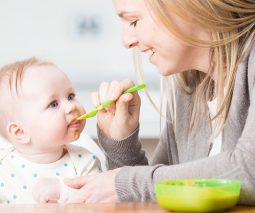How to test for allergies when your baby starts solids

It’s time to start your baby on solids, which is exciting for everyone involved, but what if your child has an allergic reaction? Heidi Young, clinical nurse specialist in childhood allergy and founder of The Nest, shares expert advice on testing for food allergies when starting solids.
The number of children affected by allergies is on the rise in Australia, and it’s something we need to consider when our baby starts on real food. “Currently one in ten under-one-year-olds have a diagnosed food allergy,” says Heidi. “Once you get past the age of one, between four to eight percent of children still have their food allergy. A lot of children grow out of their food allergy by the age of five but obviously, some won’t.”
Listen to Heidi Young on Feed Play Love:
Just pop the food in
Heidi says the best way to try certain foods is to put it in your child’s mouth, and not on the skin or the lips. “The only way is to pop it in the mouth,” she says. “And just maybe like an eighth of a teaspoon is something that we would say, or an eighth of a piece of bread if you were checking wheat.”
Then there are basic guidelines to follow in terms of watching for a reaction. “We would give an eighth of a teaspoon, and then we would wait half an hour. Then we would give a quarter of a teaspoon and wait another half an hour. Then give them half a teaspoon, wait another half an hour and, finally – give them a whole teaspoon,” Heidi says, adding that “most allergic reactions will happen relatively quickly, usually within half an hour.”
If your child is okay with that, Heidi then recommends continuing to give the food over the next few days. “Just a whole teaspoon and then keep it in the diet. For children who might have a sensitivity looming, or show that they might have some allergies, if you give something that they’re okay with and then you take it away again for six weeks, the body could see it as the enemy because allergy is an overreaction of your immune system,” says Heidi. “We see so many children who have become re-allergic to something because they’ve gone home and just not eaten it.”
What foods to try
There are nine common allergenic foods which should be tested as early as possible, including egg, milk, wheat, soy, peanut, fish, sesame, shellfish and tree nuts. “They’re the ones that we say to introduce between four to six months,” says Heidi. “The only thing that you should not be giving your child in the first year is honey, but that’s completely separate. That’s to do with listeria, and not to do with allergy. The other thing is that they say cow’s milk isn’t good for a baby under one.”
What does an allergic reaction look like?
Signs of an allergic reaction include risen bumps, known as hives or welts, which appear anywhere over your child’s body. “Hives and welts are a symptom and then any swelling, especially around the face, swelling of the lips and the eyes can look quite dramatic, and abdominal pain,” Heidi explains.
While these reactions might not look very nice, they are mild to moderate reactions and have nothing to do with the respiratory or the cardiac system. “Once the cardiac and the respiratory system get involved, that is when it’s anaphylaxis. That’s when you get the swelling in the throat and the persistent cough. Sometimes very young children will get pale and floppy, older children will say they’re dizzy,” says Heidi.
For a mild to moderate reaction, Heidi says she would give an antihistamine to take down the swelling, which can take 20 to 30 minutes. “But then you keep watching them for any of those signs of anaphylaxis like the noisy breathing.”
“If there’s swelling in the throat, a change in their voice, dizziness, or any of the signs on an ASCIA action plan, then the only thing that’s going to help is adrenaline or the EpiPen.”
When to call the ambulance
“If you see any signs of anaphylaxis, anything that is compromising their breathing. If they’re pale and floppy, or there’s a persistent cough just after you’ve fed them food, or a wheeze which is the noisy breathing, then you would immediately call an ambulance,” says Heidi. “And you would say that you are suspecting a severe allergic reaction or that the breathing is compromised.”
While mild reactions do not require an immediate trip to the hospital, Heidi still advises going to a specialist. “If there’s swelling and there are hives, then definitely [see an allergy specialist] because you can see that’s an allergic reaction. It’s not really going be anything else, especially if you’ve just fed them one of the common foods,” she says. “It’s not a medical emergency with just those symptoms of mild to moderate reaction, but I would go straight for the specialist.”








